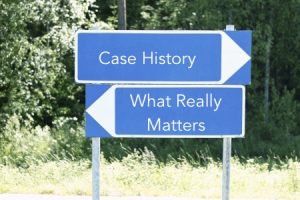 Kris English, PhD
Kris English, PhD
The University of Akron/NOAC
As mentioned in Part 1/5 of this 5-part series, Stewart et al. (2014) offer a framework to help us understand and implement Patient-Centered Care (PCC), organized around four interactive components. In this entry, we will consider the first component, Exploring Heath, Disease and the Illness Experience.
The very phrase may strike audiologists as odd: after all, we communicate with patients from the onset, starting with the case history. How is that different from exploring? Exploration does include the typical case history (“history, physical, lab”), but that step alone certainly does not encompass the entirety of the patient’s experience. In audiology, patient-centered care also strives to understand patients’ “unique perceptions and experience” of hearing loss: what it means to them, their thoughts and feelings about their experience, how HL is affecting their lives, and their expectations re: hearing help. These concerns are not necessarily revealed while collecting health and hearing history.
We know full well that hearing loss impacts “the self” (self-concept, self-confidence, self-efficacy), as well as family relationships, social interactions, community engagement, leisure activities. Patients may be distressed about these impacts and want us to understand them, or they may not be ready to accept the reality that their hearing is changing. Whatever the starting point, in addition to collecting case history information (by definition “ear-centered”), we are also challenged to find ways to explore our patients’ “unique perceptions and experience” of hearing loss.
What does exploration look like in audiology practice? Good news: it does not involve radical changes. Even better news: exploration adds an additional level of essential human connection to the encounter.
Exploration does involve authentic curiosity and a few key questioning, listening, and responding skills. For example …
“What Brings You Here Today?”
 A very familiar start! And also a patient-centered start. However, after a patient’s first few sentences, we reach a conversational crossroads and make a decision: either transition to the “history” piece, or explore a little further to find out what really matters to the patient.
A very familiar start! And also a patient-centered start. However, after a patient’s first few sentences, we reach a conversational crossroads and make a decision: either transition to the “history” piece, or explore a little further to find out what really matters to the patient.
As Stewart at al. (2014) observe, “The reasons patients present themselves to their practitioners when they do are often more important than the diagnosis” (p. 49). What are the reasons? How can we find out? Following are three tips for intrepid audiology explorers:
 Explorer Tip #1: Discussing Self-Assessment Reports
Explorer Tip #1: Discussing Self-Assessment Reports
When a patient completes a self-assessment, we often glance over the results and then add it to our report with no discussion. If so, we miss an opportunity to explore. Self-assessments give patients a framework to reflect upon and disclose pieces of their lives; the results are a natural springboard for an exploratory conversation. Even if the self-assessment addresses only situational challenges (e.g., work, restaurants), we can invite personal observations: “You indicate here sometimes feeling embarrassed when meeting new people (per HHIE-S, Newman & Weinstein, 1988). Does an example come to mind? Could you tell me more about it?” We might learn what embarrassment means to this unique patient: that it may mean choosing to opt out of social settings, that the experience also includes frustration, discomfort, discouragement, worry. However the patient frames the experience, putting those concerns into words begins a self-help process: patients gain meaning, and eventually mastery, of their situation. The invitation to elaborate may not be accepted but we should still try, because “tell me more about it” is a fundamental patient-centered practice.
Explorer Tip #2: Using Open-ended Questions
Open-ended questions come easily to some audiologists, while others worry about losing control of the conversation. It can take some practice and perhaps asking a colleague for moral support, but it’s worth the effort. Insisting on conversational control is the antithesis of PCC.
Examples of open-ended questions include:
- “You’ve helped me understand your family’s concerns. What are your thoughts?”
- “So you are thinking about hearing help – sometimes it helps me to know ‘why now?’ Has anything specific come up?”
- “A few things you’ve mentioned suggests you might be worried about what other people will think about you using hearing aids. The worry about stigma is something many patients mention. Is this on your mind as well?”
A caveat re: open-ended questions: Not every patient will want to actively participate in these conversations, and they have a right to decline. As van Dulman (2003) puts it, “Listening to patients and having them decide how much they want to participate may actually be the essence of patient-centered care” (p.195).
Explorer Tip #3: Listening and Waiting
Whether from self-assessments or spontaneous conversation, we hope to engage our patients and learn how we can help. As they answer our question, “What brings you here today?”, patients tentatively drop their guard, begin to feel accepted, and decide whether we can be trusted. That trust must be in place before patients decide to move forward.
As we know, listening requires our full attention (no multi-tasking); therapeutic listening also requires us temporarily to refrain from advice-giving and problem-solving. It is often not in an audiologist’s nature to “let a patient feel the way she feels,” but patient-centeredness is based on this principle. When patients express gratitude for our time and attention, we may find ourselves saying “all I did was listen,” but we will also know why it helped.
If you think you already understand how someone else feels or what they are trying to say, it is a delusion. … There is always more to learn. (Stone et al., 2009, p. 170)
Worried about silences? Think about them as waiting; it can make a difference in our comfort level.
The Ultimate Question: Is “Exploring” an Evidence-Based Practice?
See Zolnierek and DiMatteo (2009) to learn more.
NEXT: Audiology Counseling and Patient-Centered Care, Part 3/5: Understanding

- During my first conversation with new patients, I can recognize the “conversational crossroad” when it approaches.
Almost always Sometimes Not Sure
- I am comfortable using a self-assessment to explore a patient’s experiences living with hearing loss.
Almost always Sometimes I haven’t tried this approach
- I am generally comfortable using open-ended questions.
Almost always Sometimes Not usually
- By the end of an appointment with new patients, I have learned something unique about them.
Almost always Sometimes Not usually
- I can explain why Patient-Centered Care is an evidence-based practice.
Yes Still working on it

References:
Newman, C., & Weinstein, B. (1988). The Hearing Handicap Inventory for the Elderly as a measure of hearing aid benefit. Ear and Hearing, 9(2), 81-85.
Stewart, M., Brown, J.B., Weston, W.W., McWhinney, I.R., McWilliams, C.L., & Freeman, T.R. (2014). Patient centered medicine: Transforming the clinical method (3rd ed.). London: Radcliff Publishing.
Stone, D., Patton, B, & Heen, S. (2009). Difficult conversations: How to discuss what matters most. NY: Viking.
van Dulman, S. (2003). Patient-centeredness. Patient Education and Counseling, 51, 195-196.
